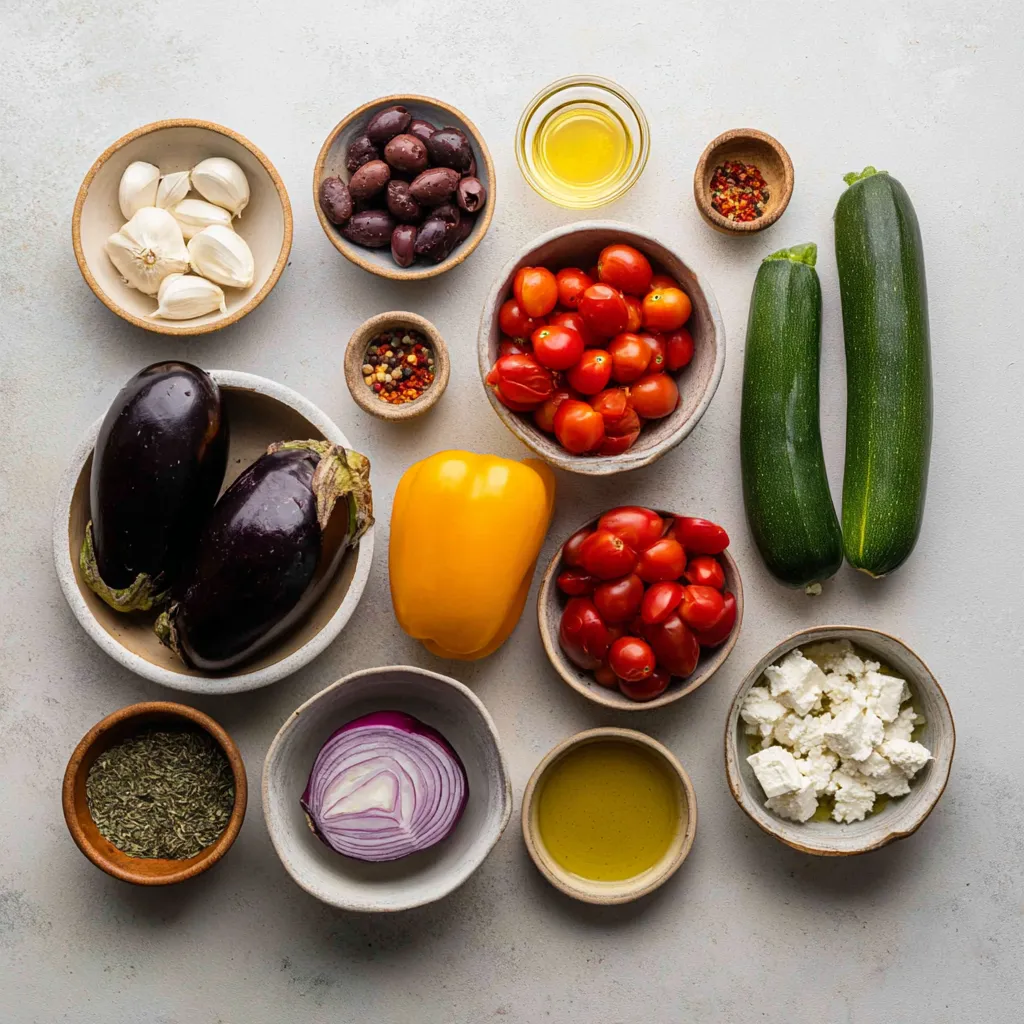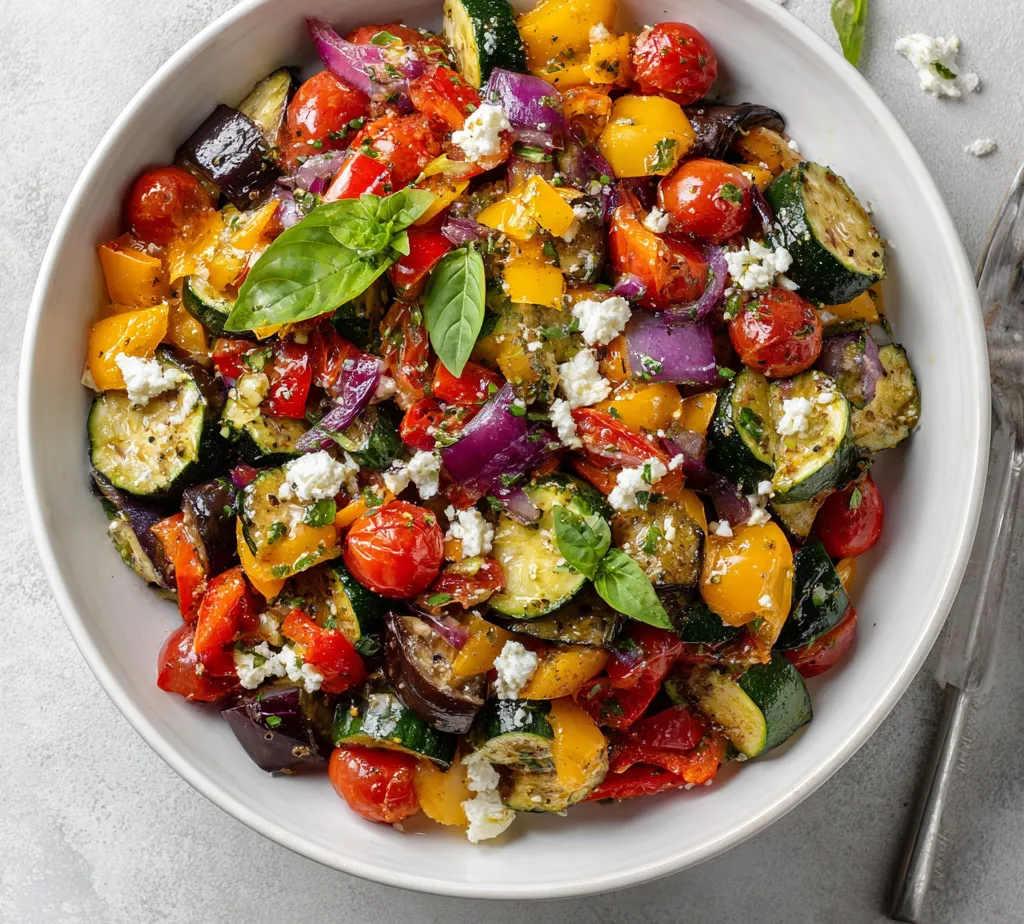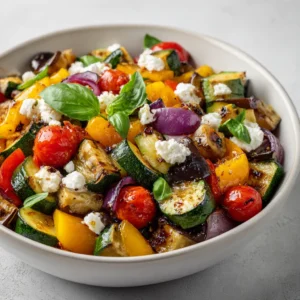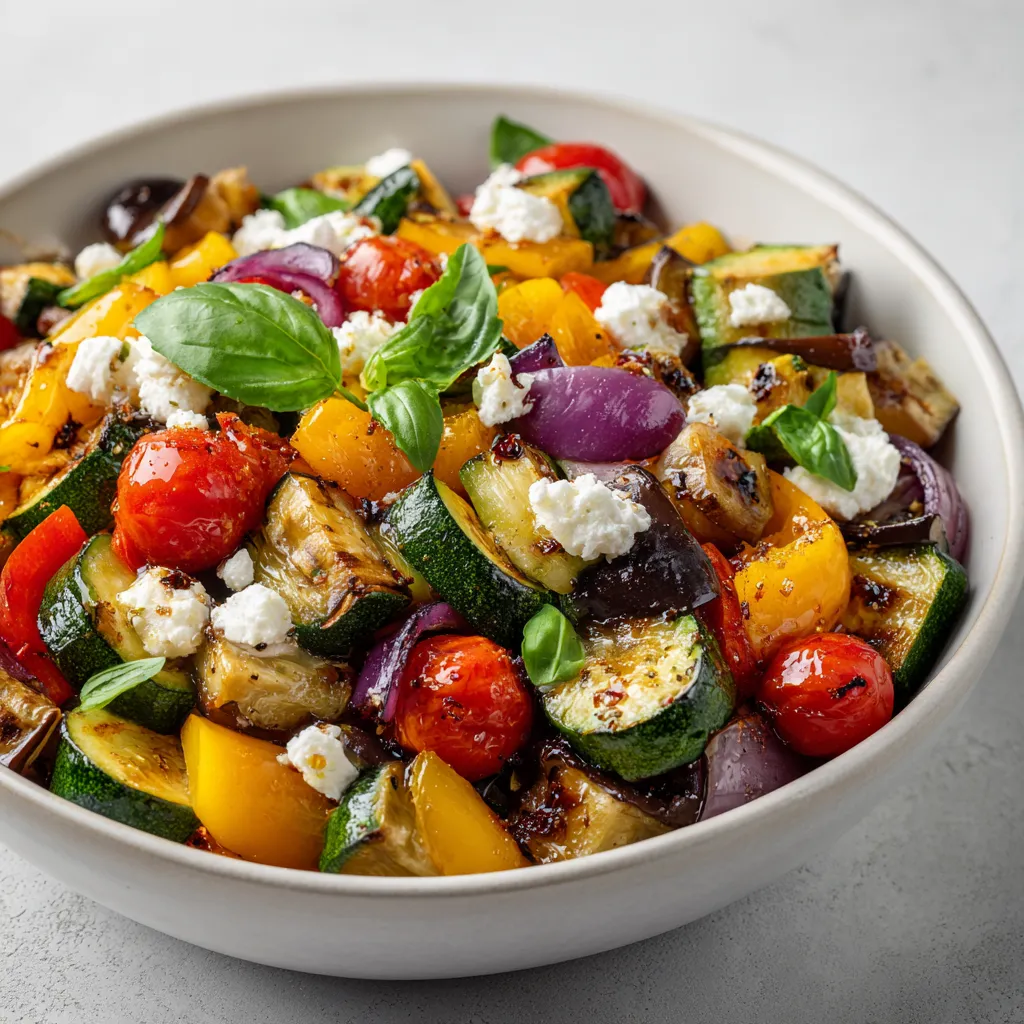Introduction
Mediterranean cuisine is renowned for its vibrant flavors, aromatic herbs, and an abundance of fresh vegetables. It emphasizes healthy eating that is not only good for the body but also delightful for the palate. In this context, the Mediterranean Veggie Medley stands out, combining a rich array of ingredients that showcases the beauty and health benefits associated with the Mediterranean diet. Packed with fiber and essential nutrients, the medley promotes overall well-being while delivering a burst of taste that can elevate any meal.
Incorporating fresh vegetables into daily meals is paramount for maintaining a balanced diet. The medley features a colorful variety of vegetables, each contributing unique flavors and nutritional benefits. Slow cooking further enhances this dish by allowing the ingredients to meld together, creating a flavorful symphony that is hearty and satisfying. It’s an ideal option for those looking to enjoy a wholesome meal without the hassle of constant monitoring.
Slow cooking offers a convenient method for preparing meals, especially for busy individuals and families. The simplicity of tossing ingredients into a slow cooker and letting them cook over several hours cannot be overstated. It allows flavors to develop fully and makes meal prep straightforward, particularly for those who wish to come home after a long day to a warm, nutritious meal waiting for them.
Recipe Overview
– Total Time: 6-8 hours
– Yield/Servings: 4-6
– Difficulty: Not specified in the recipe
Ingredients
– 1 medium eggplant, cut into bite-sized cubes
– 1 zucchini, sliced into half-moons
– 1 red bell pepper, diced
– 1 yellow bell pepper, diced
– 1 cup cherry tomatoes, halved
– 1 medium red onion, thinly sliced
– 4 cloves garlic, minced
– 1/4 cup Kalamata olives, pitted and halved
– 2 tablespoons olive oil
– 1 teaspoon dried oregano
– 1 teaspoon dried thyme
– 1/2 teaspoon red pepper flakes (optional)
– Salt and freshly ground black pepper, to taste
– Fresh basil leaves, for garnishing
– Crumbled feta cheese, for serving (optional)

Instructions
1. Prepare the Vegetables: Begin by thoroughly washing all the vegetables. Cut the eggplant into bite-sized cubes and slice the zucchini into half-moons. Dice the red and yellow bell peppers, halve the cherry tomatoes, and thinly slice the red onion.
2. Combine Ingredients: In a large mixing bowl, carefully mix together the diced eggplant, zucchini slices, both diced bell peppers, halved cherry tomatoes, sliced red onion, and minced garlic. Gently fold in the Kalamata olives to ensure they are evenly distributed.
3. Seasoning: Drizzle the olive oil over the mixed vegetables. Add the dried oregano, thyme, and red pepper flakes if you crave some heat. Season with salt and pepper to taste. Toss everything thoroughly to ensure all the veggies are well-coated with the oil and herbs.
4. Transfer to Slow Cooker: Pour the seasoned vegetable mixture into the slow cooker, spreading it out evenly to ensure even cooking.
5. Cooking: Cover the slow cooker with its lid and set it to low for 6-8 hours, or high for 3-4 hours, based on your preference for vegetable tenderness. If possible, stir occasionally to blend the flavors.
6. Serving: After the cooking time is complete, taste the medley and adjust the seasoning if necessary. Serve the warm vegetables, garnishing with fresh basil leaves and a sprinkle of crumbled feta cheese if desired.
7. Enjoy: This Mediterranean veggie medley makes for a delightful main or side dish and can also be tossed with cooked pasta or quinoa for a filling and nutritious meal.
Preparing the Vegetables
Proper preparation of vegetables is crucial in achieving the best flavors and textures in the Mediterranean Veggie Medley. Start by ensuring all vegetables are washed thoroughly; this ensures that any soil or pesticide residues are removed. Taking the time to cut the vegetables uniformly not only enhances the presentation but also aids in even cooking. For the eggplant, cutting it into bite-sized cubes helps it to absorb flavors and become tender without losing its structure during slow cooking.
The zucchini, when cut into half-moons, adds a unique texture to the medley, contrasting nicely with the denser eggplant. When dicing bell peppers, aim for uniform pieces that will cook at the same rate as the other vegetables. Cherry tomatoes add juiciness and sweetness, and halving them allows the natural flavors to escape and meld with the other ingredients. Lastly, slicing the red onion thinly is essential; this ensures that the onion softens beautifully during the slow cooking process, creating a sweet and caramel-like flavor that complements the other ingredients.
Combining Ingredients
When it comes to combining the ingredients, it’s important to handle them gently, especially when mixing in the Kalamata olives. Olives bring a salty, briny punch to the dish and should be added last to avoid bruising the softer vegetables. Mixing the vegetables in a large bowl allows for adequate space to gently fold the mixture together. Employing a folding technique — as opposed to vigorous stirring — preserves the integrity of each vegetable piece while ensuring an even distribution of flavors.
The benefits of including Kalamata olives extend beyond flavor; they are also packed with antioxidants and healthy fats. When the olives are incorporated into the mix, they infuse the medley with richness and depth. The final vegetable combination should be vibrant in color and aroma, a sign that each vegetable will release its essence into the slow cooker and contribute to a cohesive dish.
Seasoning the Medley
Seasoning is integral to bringing out the best in this vegetable medley, and the choice of olive oil plays a significant role. Olive oil not only enhances the flavor but also helps the vegetables cook more uniformly by providing a medium for the herbs and spices to adhere to. The inclusion of dried oregano and thyme is a quintessential element of Mediterranean cuisine, both offering a fragrant, earthy base that complements the vegetal freshness of the dish.
Adding red pepper flakes is optional. If you appreciate a little heat, they provide a delightful contrast to the sweetness of the roasted vegetables. When seasoning, it’s crucial to start with a modest amount; one can always adjust and add more as the flavors develop during cooking. Salt and freshly ground black pepper should be used thoughtfully to elevate the natural flavors of the vegetables rather than overpower them.
With each layer of seasoning, the vegetables become infused with flavor, promising to deliver a deliciously aromatic and sumptuous medley that embodies the essence of Mediterranean cooking.

How to ensure the lid seals properly to retain moisture
To guarantee that your slow cooker lid seals effectively, it is essential to check the rubber gasket around the lid for any cracks or wear. A proper seal prevents steam from escaping, ensuring that the dish cooks evenly and retains moisture. When placing the lid, make sure it sits snugly over the edges of the pot. Additionally, avoid frequently lifting the lid during cooking, as this can cause drastic temperature fluctuations that hinder the cooking process. If you must check on the dish, do so quickly and refrain from prolonged exposure to the heat.
Cooking Time and Method
Insights into the slow cooking process and how it affects flavor development
Slow cooking provides a unique advantage, allowing flavors to meld gradually as the ingredients saturate in their own juices and released moisture. With a lower cooking temperature, the eggplant, zucchini, peppers, and onions become tender without losing their distinct characteristics, creating a harmonious blend of flavors that typify Mediterranean cuisine. The long cooking time also allows for the infusion of olive oil and herbs, marrying their aromas with the veggies.
Suggested methods for occasional stirring and what to look for during cooking
While stirring isn’t required, giving the medley a gentle stir once or twice during the cooking process can enhance flavor distribution. Pay attention to vegetable doneness; you should be looking for a tender texture without any pieces becoming mushy. Additionally, keep an eye on the liquids in the slow cooker; if they start to look overly watery, lifting the lid and allowing some steam to escape can help concentrate the flavors.
Differences in texture and taste between low and high cooking settings
Cooking on the low setting results in softer vegetables with a creamier texture, as they have more time to release their moisture. Expect the flavors to meld beautifully, resulting in a well-balanced dish. On the other hand, cooking on high yields a firmer texture, as there is less time for the vegetables to break down. This method is ideal if you prefer a robust bite while still enjoying the infused flavors from the herbs and seasoning.
Adjusting Seasoning
Guidelines for tasting and adjusting the seasoning post-cooking
Once the cooking time has concluded, it is essential to taste the dish before serving. The slow cooking process often mellows the spices, making it necessary to adjust the seasoning to restore balance. Take a small sample to determine if it requires more salt, pepper, or acidity from a splash of lemon juice or vinegar to elevate the dish. It’s best to adjust the flavor profile in small increments, tasting continuously until it reaches your desired level of seasoning.
Overview of common seasoning adjustments (salt, pepper, herbs)
Adding additional salt can enhance the overall flavor, while fresh ground black pepper introduces a mild heat. If you seek to amplify the herbal notes, consider adding more dried oregano or thyme, as these herbs hold up well during the cooking process. In contrast, enhance the dish just before serving with fresh herbs, ensuring that the flavor remains vibrant and fresh.
Suggestions for balancing flavors based on personal preference
Every palate is different. If enjoying a milder flavor spectrum, reduce the amount of red pepper flakes or omit them entirely. On the other hand, if you prefer more warmth, feel free to incorporate a pinch of chili powder or paprika to enhance the spice without overpowering the natural flavors of the vegetables. Additionally, a drizzle of balsamic vinegar or a hint of lemon zest can brighten the medley and create a lovely contrast to the richness of the olives and feta.
Serving Suggestions
Ideas for garnishing with fresh basil and crumbled feta cheese
Garnishing with fresh basil leaves not only adds a pop of color but also infuses an aromatic freshness to the dish. Crumbled feta cheese provides a deliciously creamy and tangy contrast, enhancing the Mediterranean flair of the veggie medley. Consider mixing the feta into the medley just before serving or providing it on the side for guests to add according to their preference.
Presentation tips for a visually appealing dish
Present the medley in a large, shallow bowl to showcase the rich colors and textures. A simple yet effective technique is to create a bed of washed and torn lettuce or arugula at the bottom of the bowl before layering the veggie medley on top—this not only adds visual appeal but also contributes an extra layer of flavor. Drizzle a light olive oil and balsamic reduction on top for an added touch of elegance.
Creative ways to serve the veggie medley (as a side, main dish, or pasta topping)
This Mediterranean veggie medley can be served in multiple ways. As a vibrant side dish, it pairs excellently with grilled meats or roasted fish. For a heartier meal, toss the medley with warm pasta or quinoa—creating a fulfilling main course. It can also be served over a bed of couscous or used as a filling for wraps or pita bread, making it versatile for various dining experiences.
Meal Pairings
Suggested complementary dishes that work well with the veggie medley
Complementing this dish with grilled chicken or lamb can elevate the meal, providing protein that pairs harmoniously with the vibrant vegetables. Additionally, serving it alongside crusty whole-grain bread enhances the dining experience, allowing for the perfect vessel to soak up the juices.
Wine and beverage pairings that enhance the Mediterranean experience
To accentuate the Mediterranean profile of this dish, consider a crisp, dry white wine like Sauvignon Blanc or a light-bodied red such as Pinot Noir. Alternatively, a sparkling water infused with lemon or basil can complement the flavors without overwhelming them.
How to incorporate into a larger meal plan or menu
This Mediterranean veggie medley can serve as an excellent component in a larger menu or meal plan. It can be followed by a light dessert, such as sorbet or fresh fruit, and can easily transition into lunch the next day when combined with leftovers from a grilled protein dish, creating a seamless continuity in flavors throughout your meals.
Storing Leftovers
Best practices for storing leftover veggie medley
After serving, allow the veggie medley to cool before transferring it to an airtight container. This practice helps to retain its texture and flavor when stored. Be sure not to pack the vegetables too tightly, as this may break them apart and diminish their integrity.
Recommended storage containers and refrigeration tips
Use glass storage containers or BPA-free plastic containers for longer-lasting freshness. Store the leftover medley in the refrigerator and consume it within 3-4 days for the best quality. Consider placing parchment paper between layers of the mixture to maintain airflow and prevent moisture buildup.
Ideas for repurposing leftovers in different meals
Leftover veggie medley can be easily transformed the next day. Blend it into a smooth soup for a nourishing option or incorporate it into a quiche or frittata for an easy breakfast. Use it as a vibrant topping for pizza or flatbread, or mix it into scrambled eggs for a flavorful brunch dish.
Nutritional Information
Breakdown of calories and nutrients per serving
Each serving of the Mediterranean Veggie Medley is approximately 120 calories, depending on the exact proportions used and any additional garnishes. It is a rich source of vitamins A and C, potassium, and dietary fiber, making it a nutritious addition to a well-rounded diet.
Health benefits of each primary ingredient
Eggplants are low in calories and high in fiber, promoting digestive health. Zucchini provides hydration due to its high water content, while bell peppers are bursting with vitamins and antioxidants. Tomatoes contribute heart-health benefits through their high lycopene content, and olives provide healthy fats, enhancing heart health.
Discussion on fiber, vitamins, and minerals present in the dish
The combination of diverse vegetables contributes to a high fiber content that promotes gut health. The various vitamins present, including B vitamins from zucchini and tomatoes, support numerous bodily functions, from energy production to immune response, making this dish not just delicious but nourishing as well.
Conclusion
The Mediterranean Veggie Medley invites a delightful medley of flavors and textures, providing a satisfying option for any meal. With a cooking time that allows the ingredients to meld beautifully, the dish offers a rich taste experience that balances freshness with the warmth of herbs. Perfect for busy days, it ensures a vibrant dining experience that resonates with Mediterranean charm.


